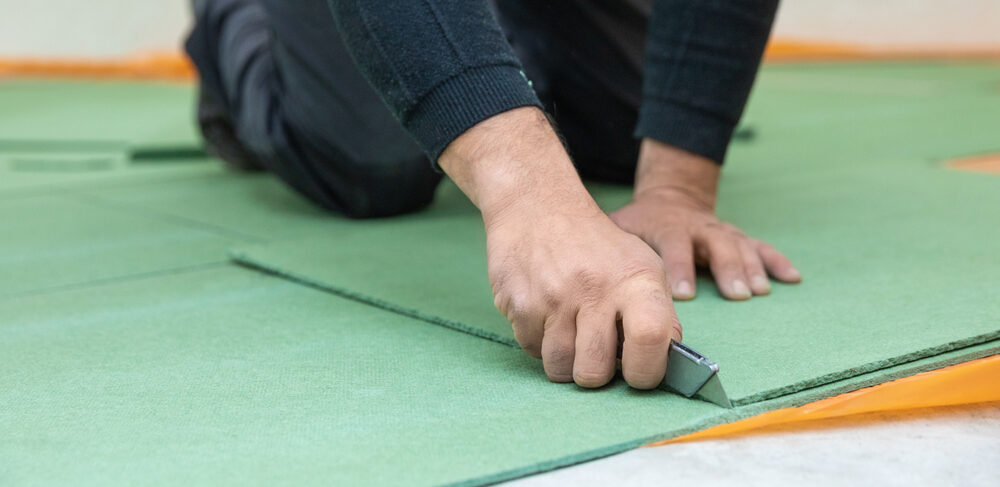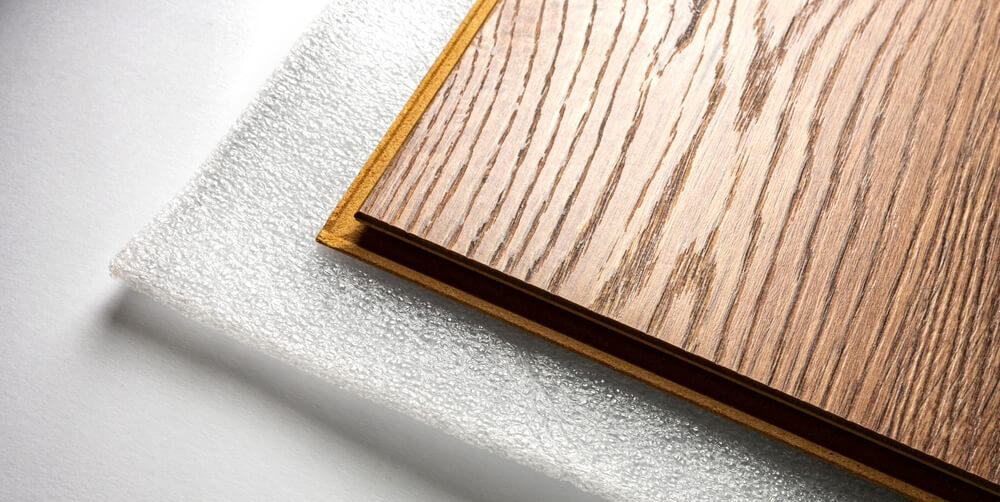Is Underlayment Necessary For Hardwood Floors?

Are you looking for comfortable floors and wondering, “Is underlayment necessary for hardwood floors?” Being flooring experts, we have helped multiple home owners with wooden floors underlay issues.
Underlayment is not always necessary for hardwood floors. However you can install it for enhanced comfort, noise reduction, and moisture control.
After extensive research, we have come up with this blog post to provide you valuable insights on wood floors underlay. This article addresses what is underlayment, types of underlay, how much underlay do i need for hardwood floors, other common questions, and myths to ensure a successful flooring installation.
What Is Underlayment for Hardwood Floors?
Underlayment is a thin layer of material installed between the subfloor and the hardwood flooring. While underlay is not always necessary, it offers advantages that can enhance the performance and longevity of your hardwood floors.
Advantages Of Using Underlayment In Hardwood Flooring
Purpose of underlayment is to provide the following various benefits:
1. Sound Reduction Benefits

Installing underlayment beneath hardwood floors helps reduce noise transmission, especially in multi-story buildings or areas with high foot traffic. According to Research, The underlayment acts as a sound barrier, minimizing the impact of footsteps and other noises, creating a quieter and more comfortable environment.
2. Moisture Barrier For Hardwood Floors
Underlayment acts as a moisture barrier, protecting your hardwood floors from potential damage caused by subfloor moisture. It helps prevent moisture vapor from seeping into the wood, reducing the risk of warping, buckling, and mold growth. This is particularly important in areas prone to moisture, such as basements or concrete subfloors.
3. Thermal Insulation
Underlayment provides thermal insulation properties, helping to maintain a comfortable indoor temperature. It acts as a barrier between the cold subfloor and the hardwood flooring, preventing heat loss and providing an additional layer of insulation. This can contribute to energy efficiency and reduce heating costs.
Underlayment Options For Hardwood Floors
Choosing the right underlayment option for hardwood flooring installation is essential to ensure the longevity and performance of your hardwood flooring. Some f the most popular types of wood floors underlay are:
1. Foam Underlayment

Foam underlayment is one of the most popular choices for hardwood floors underlay. It is typically made of polyethylene or polypropylene materials and comes in various thicknesses. Foam underlayment offers excellent sound absorption, reducing noise transmission between floors. It also provides a slight cushioning effect, enhancing the comfort which prevent foot pain caused by hardwood floors. Additionally, foam underlayment helps to reduce the impact of minor subfloor imperfections.
2. Cork Underlayment
Cork underlayment is known for its exceptional sound absorption properties. It is made from the bark of cork trees and offers natural thermal insulation as well. Cork underlayment is an eco-friendly option, as it is a renewable and sustainable material. It also has excellent resistance to moisture, making it suitable for areas prone to dampness. However, cork hardwood floor padding can be relatively more expensive compared to other options.
3. Felt Underlayment
Felt underlayment is made of recycled fibers and provides sound absorption and thermal insulation properties. It helps to reduce noise transmission and provides a comfortable feel underfoot. Felt underlayment paper is typically available in rolls and is easy to install. However, it may not offer as much moisture protection as other underlayment options.
4. Rubber Underlayment
Rubber underlayment is a durable and resilient option for hardwood floors. It offers excellent sound absorption and impact resistance, reducing noise and preventing damage from heavy foot traffic. Rubber underlayment also provides thermal insulation properties, keeping the floor warm in cold weather. It is resistant to moisture and helps to protect the hardwood flooring from potential water damage.
5. Combination Underlayment
Combination underlayment, as the name suggests, combines different materials to provide a blend of benefits. It may include a combination of foam, cork, or felt to offer enhanced sound reduction, moisture protection, and insulation. Combination underlayment allows you to enjoy the advantages of multiple materials in a single product.
Factors to Consider When Deciding on Wooden Floors Underlayment

1. Subfloor Condition
The condition of your subfloor plays a significant role in determining “do hardwood floors need underlayment?” Uneven or damaged subfloors may benefit from the use of underlayment to create a smooth and stable surface for the hardwood flooring.
2. Flooring Type and Installation Method
The type of hardwood flooring you choose, as well as the installation and refinishing method, can influence the need for underlayment. Some engineered hardwood floors come with built-in underlayment, while others may require separate underlayment for optimal performance.
3. Personal Preferences and Requirements
Consider your specific needs and preferences when deciding on underlayment. If noise reduction is a top priority, selecting a soundproofing underlayment for wood flooring would be beneficial. Likewise, if moisture is a concern, choosing an underlayment with moisture-resistant properties provides added peace of mind.
Common Myths About Underlayment for Hardwood Floors
1. It Increases Floor Height Excessively
Contrary to popular belief, underlayment does not significantly increase the overall floor height. Modern underlayment materials are designed to be thin yet effective, ensuring minimal impact on the final floor height.
2. It Alone Prevents Moisture Damage
While underlayment provides moisture protection, it should not be solely relied upon to prevent moisture-related issues. Proper subfloor preparation, including moisture testing and addressing any underlying moisture concerns, is crucial for long-term flooring durability. Underlay alne cannot eliminate the need for moisture barrier under hardwood floors.
FAQs

1. Do You Really Need Underlayment?
Whether you need underlayment for your flooring depends on various factors. Underlayment is not always necessary but can provide benefits like moisture protection, sound insulation, and a smooth surface. Assess your specific requirements, subfloor condition, and desired flooring performance to determine if underlayment is needed.
2. What Flooring Does Not Require Underlayment?
Certain types of flooring do not typically require underlayment, such as engineered hardwood (if installed as a floating, or nailed floor), and luxury vinyl plank (LVP) or luxury vinyl tile (LVT) with built-in underlayment. However, subfloor conditions and specific installation guidelines should always be considered.
3. What Happens If You Don’t Use Underlayment?
Not using underlayment can result in potential issues. Without underlayment, there may be increased noise transmission, reduced insulation properties, and potential moisture-related problems. Additionally, the absence of underlayment may lead to an uneven or unstable flooring surface, compromising the overall durability and performance of the floor.
4. Is Floor Underlayment Worth It?
Whether floor underlayment is worth it depends on factors like subfloor condition, desired insulation, sound reduction while creaking at night, and moisture control. Underlayment can enhance flooring performance and longevity, providing a smoother installation surface. Assess your specific needs and consult flooring professionals to determine if underlayment is worthwhile for your project.
5. Can You Use Plywood Instead Of Underlayment?
While plywood can be used as a substitute for underlayment in certain cases, it may not provide the same benefits. Underlayment materials are specifically designed to offer moisture resistance, sound insulation, and a smooth surface. Consider the requirements of your flooring project before deciding on plywood as an alternative.
6. Which Hardwood Floor Underlayment Is The Best For A Customer Who Needs An Easy To Install Underlayment With A Superior Sound Insulation?
For customers seeking easy installation and superior sound insulation, a foam underlayment with an attached vapor barrier would be a great choice. Foam underlayment is lightweight, simple to install, and provides excellent sound absorption properties, enhancing the overall comfort and quietness of the hardwood floor.
7. Is Expensive Underlayment Worth It?
The value of expensive underlayment depends on specific needs and budget constraints. While pricier options may offer advanced features like superior sound insulation or moisture resistance, it’s essential to consider factors such as subfloor condition and desired flooring performance to determine if the added cost is worth it for your project.
8. How Thick Should The Underlayment Be For Hardwood Floors?
The thickness of underlayment for hardwood floors typically ranges from 1/8 inch to 1/4 inch. However, it’s important to follow the manufacturer’s guidelines and consider factors like subfloor condition and desired flooring performance. Consult flooring professionals or the manufacturer for specific recommendations based on your project requirements.
9. What Is The Best Underlayment For Hardwood Floors?
The best underlayment for hardwood floors can vary depending on specific needs and preferences. However, commonly recommended options include foam underlayment, cork underlayment, and rubber underlayment. These choices offer various benefits such as sound insulation, moisture resistance, and ease of installation.
10. Does Hardwood Go Directly On Subfloor?
In most cases, hardwood flooring is not directly installed on the subfloor. It typically requires a layer of underlayment to provide moisture protection, sound insulation, and a smooth surface for installation. However, specific installation guidelines and subfloor conditions may vary, so it’s important to consult the manufacturer’s recommendations.
Conclusion
In conclusion, while underlayment is not always mandatory for hardwood floors, it offers numerous benefits that can enhance the performance, comfort, and longevity of your flooring. Factors such as sound reduction, moisture protection, and thermal insulation should be considered when deciding on underlayment.



2 Comments